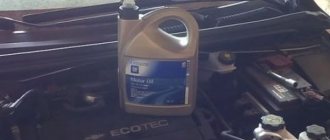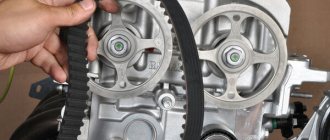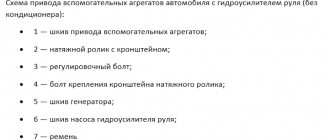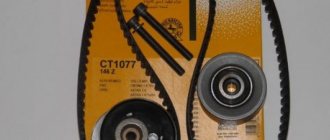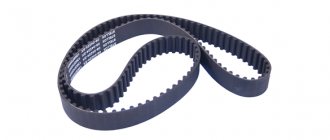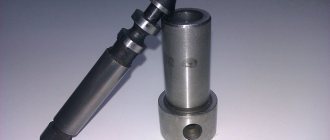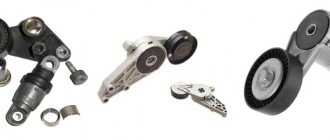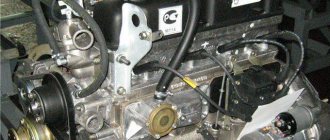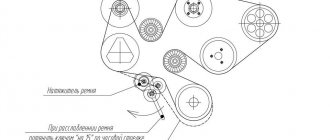The motor marked K4M is equipped with a special belt for transmitting torque. Every 50-60 thousand km it is necessary to replace it. Otherwise, if it breaks, a major overhaul of the motor may be required - which will result in large expenses.
An engine with this marking is installed in many cars. For example, on Renault Megan, Clio, Simbol, Lada Largus and many others. Buying a new belt in a store is not difficult. When buying a new one, as in the case of other parts, you have a choice: original or analogue? Each option has its own advantages.
Original
A belt positioned as original requires less frequent replacement. Usually it has a longer resource, the likelihood of it breaking ahead of schedule is extremely low. It is only important to remember that there are many fakes on sale. It is important to carefully read the signs of such. Avoid purchasing low-quality goods.
| Name | vendor code | Price, rubles |
| Power Grip (original) | 130C17529R. | From 4 800 |
Not only individual belts are available for sale. But also whole kits for doing the work yourself. This kit includes rollers and some other components. It is advisable to check all components before purchasing. Sometimes stores make mistakes. There may be incorrect parts in the box. Moreover, this fact will be clarified during the work process.
About the gas distribution mechanism
The essence of the operation of an internal combustion engine is that at a certain moment the combustible mixture is supplied to the combustion chamber, compressed, ignited, the piston moves down, turning the crankshaft, and when the piston moves up, exhaust gases are removed from the chamber. All these processes are controlled by the engine gas distribution mechanism.
It consists of several parts, these are:
- One or two camshafts, which are located in the cylinder head.
- Inlet and exhaust valves. They are installed in cast iron guide bushings, which are pressed into the cylinder head.
- Valve springs that return the valve to its original position.
- Each valve is driven by the camshaft through washers, which are selected individually for each valve to set the thermal gap. On modern engine models, hydraulic compensators are installed, which independently set the required gap between the valve and the camshaft without driver intervention.
- Timing mechanism drive. The camshaft receives rotation from the crankshaft through a toothed belt, tension rollers, and diverter rollers. At the same time, the pump in the engine cooling system rotates through the belt.
Owners should take into account that on engines with 16 valves, the belt is more loaded, since it rotates twice as many parts as on an 8-valve engine. The use of a timing belt in the timing drive made it possible to reduce the weight of the power unit. The length of the engine has become shorter, which makes it possible to install the engine transversely in the engine compartment without any problems. The noise of a running engine is much less compared to the operation of a power unit with a metal chain in the timing drive. Maintenance costs for a timing belt drive have become lower, and the job has become easier to perform. The belt mileage is quite high, but strict adherence to the recommendations of the motor manufacturers is required.
What can happen if you don't change the belt on time?
Every driver must know the operating features of the power unit of his vehicle. This fully applies to the engine timing drive.
Ignoring engine maintenance requirements can lead to serious engine damage, which will require additional financial and material costs to eliminate them. Proper maintenance allows the drive to work through its assigned life without problems. The degree of damage to engine parts due to belt failure depends on the type of engine, primarily on the design of the cylinder head.
To obtain high engine performance, it is necessary to improve the filling of the combustion chamber with the working mixture and timely removal of exhaust gases. To do this, four valves are installed on each cylinder, two on the intake and exhaust tracts (K4M). Running an engine on high-octane fuel requires an increase in the compression ratio. This is achieved by reducing the volume of the combustion chamber. If the timing belt is damaged, the valves hang in a stationary position, the pistons continue to move to top dead center.
In this case, the pistons “meet” with the valves, they become bent, and damage to the pistons and connecting rods is possible. Repairers give many examples when the entire cylinder head was subjected to major repairs after such a “meeting”. Renault Logan engines, which have eight valves in the head, also experience such damage. These are K7J, K7M engines.
Analogue
Many analogues are in no way inferior to the originals in their resource. But before purchasing a certain type of part, you should carefully read the reviews and characteristics. Today, the optimal price-quality ratio is:
| Name | vendor code | Price, rubles |
| Gates kit: belt, rollers Renault Lada Nissan K4M | K016PK1823XS | From 3 thousand rubles |
| AYWIPARTS | AW2110070 | From 800 rubles |
| LYNXAUTO | 132FL27 | From 930 rubles |
Features of timing belt placement
Before we look at timing belt removal, it should be said that different engines may have different timing gear placement. The timing belt is a long rubber belt with a toothed surface.
By the way, when choosing a belt, you should pay attention to the toothed surface. You should squeeze the belt and check if there are any grooves left on it.
If you find abrasions, this is the first sign of a low-quality product. It is not recommended to buy such a belt.
On some vehicles it is more involved to access it, but it is always located outside the engine and accessible somehow. If you are unsure how to access and inspect the timing belt, consult your repair manual. To inspect a belt, first look at the outer surface of the belt to see if any tiny cracks are forming.
The timing belt is a very strong metal strip with rubber on the outside. The rubber should be fairly smooth, without any chunks or massive cracking. One or two small cracks in the belt's outer shiny coating is OK, but if you see many cracks in the surface, it may indicate excessive wear.
If you cannot decide on the choice of belt, we recommend that you read the article.
What is necessary
Before starting work, you must prepare:
- set of open-end wrenches;
- rags;
- set of heads;
- hammer and screwdrivers (slotted, Phillips);
- a wire brush and gasoline to clean the engine.
In addition to the tool, you will also need: a timing belt and two rollers (tensioner and bypass). Renault sells repair kits for its cars. It includes everything you need. Catalog number – 7701477014. It is advisable to purchase replacement parts only in well-established stores.
Progress of work on replacing the timing belt 16 valve K4M
Drive the car into a garage with an inspection hole, remove the right front wheel and fender liner mudguard. Lower the vehicle onto jack stands. This will give you access to the crankshaft pulley (1), alternator belt (2), and tension roller (3).
Start of replacement
Using a 13 or 15 mm wrench (depending on the car model), pull the tension roller and remove the generator drive.
Then we find the plug for the hole for locking the HF, and unscrew it with a 14mm head.
We support the crankcase from below with a jack, unscrew the 6 bolts securing the right K4M support with a 16mm socket.
It is better to support the engine with a jack so that if necessary you can lower or raise the engine
Mounting the K4M engine mount
Remove the air receiver (on the other side of the engine). This will give you access to the camshaft plugs. We pierce it in the center with a screwdriver and pick it out.
Crankshaft hole plugs
Now attention! We rotate the CV until the slots at the ends of the CV are horizontal.
Next (remember how you removed the crankshaft stopper plug?) you need to insert a special locking bolt in its place and fix the CV.
After inserting the locking bolt, tighten it by hand until it stops, turn the crankshaft slightly and it will lock. After this, we fix the RV with a special device.
Fixing the camshafts
Unscrew the rod fastenings (1) and (2), discard the rod. Next, unscrew the KV pulley (3) and remove it.
Removing the timing belt
Remove the plastic cover and then the metal part. The plastic one is held on by 4 bolts. The metal cover has 3 bolts and 2 13 mm nuts. It is inconvenient to unscrew, having to lift or lower the engine.
After removing the covers, access to the tension roller will open. Mark the arrow position with a marker. Remove the belt, remove the tension and guide roller (removable with the bushing).
Then use a puller to remove the gear from the crankshaft.
Check the condition of the water pump roller.
Installing a new timing belt according to the marks
Before reassembling, check the removed components, replace them with new ones from the kit, check the condition of the crankshaft seals and pumps. Clean the seats. Install a new tension roller (1). Be careful, there is a slot on it, you need it to fit into the groove. Screw the nut on by hand, then install the guide roller (2) and secure it all the way.
We start the K4M timing belt. First, we put it on the camshaft gears, pass it onto the idler, the pump gear, and the tensioner. The loose strap loop will drop down. Advice: check the position of the CV, tighten the bolt with the locknut, try to turn it slightly clockwise. The shaft will rest. Carefully remove the bolt. The slot for the key is strictly vertical to the shaft axis.
We install the crankshaft gear. You can lift the engine a little to make it easier to fit the gear onto the shaft.
We do the tension: insert the hexagon (1), turn the eccentric (2) clockwise, make sure that the flag (3) is aligned with the slot, (4) tighten the fastening bolt until it stops.
Remove the locking screw from the crankshaft and the device from the camshafts. We make one revolution of the crankshaft, look at the alignment of the RV slots. The device should fit into the slots again, which means correct installation.
Assembly
First we install the metal cover, then the plastic cover. For ease of mounting, you can slightly raise or lower the K4M engine. Don't forget about the crankshaft plugs, RV. We put the generator drive pulley on the crankshaft, and at the same time change the generator belt. We put the remaining disassembly elements in their places. We check the oil and coolant levels, connect the battery terminal, and turn on the ignition. We check the operation of the K4M at idle and while driving at speed.
K4M under the hood of Nissan Almera G15
